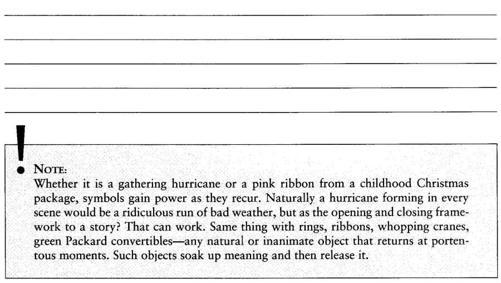Writing the Breakout Novel Workbook (41 page)
Read Writing the Breakout Novel Workbook Online
Authors: Donald Maass

A more amusing symbol is waiting for the Price family upon their arrival: an African gray parrot named Methuselah who was left for them by their predecessor. Unfortunately, Methuselah mimics human speech. The parrot is, consequently, somewhat foul-mouthed. When Nathan Price first hears Methuselah growl "Piss off," he declares, "That is a Catholic bird." Methuselah gets the girls in trouble, and eventually escapes and flies away into the jungle. He would be nothing more than comic relief, but Kingsolver later brings Methuselah back to devil Nathan Price with his uncensored mimicry. The bird becomes a symbol, standing in for the persistence of the jungle, local culture, political reality, and Price's own failure to have an impact on the community that he has come to convert to Christianity.
Are there physical objects or recurring events that might serve as symbols in your novel? The exercise that follows asks you not to impose symbols on your manuscript, but to discover them already there, buried like artifacts that readers can happen upon and enjoy, either consciously or not, for the extra meaning that they add to your story.
Creating Symbols
Step 1: |
 |
Step 2: |
 |
Step 3: |
 |
Follow-up work:
What is the opposite of that object, event, or action? Find a place for that to appear or occur too.
Make notes.

Conclusion:
Sometimes called objective correlatives, symbols can be overly obvious, but when cleverly chosen and tactically deployed they can punctuate a story in powerful ways.
Brainstorming
D
id you ever hear a premise, snap your fingers, and think to yourself, "Now,
that
is a great idea for a story!" Of maybe you thought, "Dang, I wish I had thought of that one myself!"
Some ideas are like that: They immediately engage. They are naturals. Right away the story begins to write itself in your head. You can see what will happen first and exactly how it will go after that. Strangely, although the story already is familiar, so much so that you have begun to appropriate it, your feeling is not "How common," but "How original!"
What causes that reaction? Why is it that although there are no new stories, some ideas nevertheless feel fresh? I believe that there are several qualities that can invoke that feeling.
First is the surprising new twist on an old idea. Take the murder mystery: The essential story is the same every time. Someone is killed, and a detective figures out who did it. So familiar is this formula that it is frequently reduced to "whodunit." Many mystery manuscripts are pitched to me, and most feel as tired as the formula. They lack spark, meaning they bring nothing new to the genre. But now and again an idea comes along that's got a brand-new twist.
Every detective has a
method
of detection. It started with the ruthless logic of Sherlock Holmes. But logic is not the only way to arrive at a solution. Gut intuition is another, but that, too, has become commonplace. What is left? In Matthew Pearl's T
he Dante Club,
set in 1865 in the city of Boston, a killer is dispatching his victims in gristly ways reminiscent of Dante's
Inferno.
Since Dante's work is not yet translated into English in 1865, Boston's scholars fear that they will be suspected. It is understandable, then, when this limited circle (the "Dante Club" of the title) bands together to catch the killer and clear their collective name.
Had Pearl merely assembled, as he does, four famous names of the era (Oliver Wendell Holmes, Henry Wads worth Longfellow, James Russell Lowell, and publisher J.T. Fields)
The Dante Club
would not have felt original. Historical figures have turned into detectives many times. It is this group's special expertise in Dante and how they employ it to catch a killer that pro-
vokes a snap of the fingers. Even better, Pearl uses Dante not only to color the killer, but as a lens to view tensions in the halls of Harvard and in the streets of Boston, where waves of immigration are changing the face of America.
Just as there are methods of detection, there are means of murder, or
modus operandi.
An example can be found in Alice Blanchard's
The Breathtaker.
In this whirlwind thriller, Blanchard spins the story of a small-town police chief, Charlie Grover, who must track a serial killer who strikes only during tornados.
Blanchard told
Publishers Weekly
in an interview that she likes "when a person is confronted with something huge. When someone murders, they rip through someone's life like a tornado will rip through a land and tear everything apart." So it is for Charlie Grover, who in additional plot layers faces the scars left by a childhood fire that killed his mother and sister, and who in the present copes with a sixteen-year-old daughter who is enchanted by a troubled teenage storm chaser.
Wounded detectives and detective dads are nothing new. It is the twisters that stir up
The Breathtaker
and give it originality.
Combining two stories in unexpected ways can be a synthesis that also feels original. Hollywood novels have been written for years. So have novels about diseases and their effects. But putting those together? That is what Elisabeth Robinson does in
The True and Outstanding Adventures of the Hunt Sisters),
the story of struggling Hollywood film producer Olivia Hunt, who chronicles a year during which her sister in Ohio is diagnosed with leukemia. The parallel stories of Olivia's attempt to produce
Don Quixote
and her visits to her dying sister are not obviously compatible, but they work together in ways that they would not if they stood alone. Their combination is original.
Sometimes it is nothing more than the gut emotional appeal of a story that sweeps away comparisons and makes it feel one-of-a-kind. Elizabeth Berg is good at this. She told
The Writer
that her stories start with nothing more than a feeling, a practice that has pulled her into novels about coming to terms with an abusive father
(Durable Goods),
women helping a friend through breast cancer
(Talk Before Sleep),
and a wife's persistence while her husband is in a coma (
Range of Motion).
None of these premises are particularly new, but Berg's ability to get to the emotional heart of these situations has made her a best seller.
Nicholas Sparks also can tug at his readers' heartstrings in ways that make his novels more than run-of-the-mill romantic tragedies. Sparks started his first blockbuster,
The Notebook,
with an ending. Sparks told
Writer's Digest
that he knew it would have to be powerful enough to generate word of mouth. It involves a death (speaking of high moments), but prior to that his story successfully captures the wonder of everlasting love. Who can resist that? Go deep enough, as Sparks does, and readers may feel that they have never before experienced this special bliss.
A reversal of the expected also can feel original. For instance, most single women would not care to become pregnant, right? The results of home pregnancy tests usually are dreaded. But in Lauren Baratz-Logsted's debut novel,
The Thin Pink Line,
named for the telltale line on a pregnancy test strip, London editor
Jane Taylor finds herself pregnant and learns that she likes it. Her lackadaisical boyfriend suddenly seems ready to commit. Friends and strangers treat her well. When it turns out that she is not pregnant after all, Jane fakes it for nine months. Jane's escalating efforts to maintain the ruse are hilarious, and steadily ratchet up the stakes in Baratz-Logsted's most original reversal.
Another lighthearted flip-flop of the familiar can be found in Sherrilyn Kenyon's romance
Fantasy Lover.
Kenyon's heroine is sex therapist Grace Alexander. You would expect that someone in her profession would have a healthy enjoyment of eroticism, but Kenyon neatly upends that expectation. Grace hates sex. Indeed, she has been celibate for four years. Who is the perfect foil for this repression? Who else? A Greek god, and so one is summoned by Grace's friend Selena from the pages of an ancient tome where he is cursed to live until he is called out once in a while to . . . um, lend a hand.
Julian of Macedon, half god, half mortal, fortunately is up to the job of thawing Grace's libido. In yet another switch it turns out that something else needs thawing: Julian's heart, which is frozen thanks to the once-cruel life that cursed him. These two are inwardly conflicted. Kenyon also, by the way, tosses in a cast of secondary characters that includes Julian's family of Greek gods and goddesses. Talk about complications! Retold myths and fairy tales are common in the romance field today, but Kenyon's employment of the power of reversal makes
Fantasy Lover
stand out.